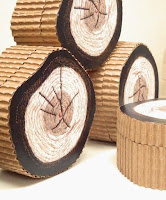Wrapping it up: Packaging and Branding
Around this time I ordered a necklace online. It arrived in a lime green gift box, with a black ribbon, and a logo sticker, in a black gossamer drawstring bag. It was like a club to my head. No matter how cool my item was I clearly needed to step up the wrapping.
As I thought about choosing a box, a coordinating ribbon, adding a logo, picking all the bits and pieces, I realized that, even if I chose recycled materials, I would be sending out paper-goods that would just be thrown away. All my work on branding would be lost and the materials would become landfill. And that really bugged me.
But what if I could make the box worth keeping? What if I could make the function match the purpose, the item, even the customer. And most importantly, what if I could make the customer say, "Wow!" when they opened the mail. What if I could make them gasp?!
So that is what I try to do, and packaging has become another part of my artistic process. I designed a round jewelry box made from recycled cardboard that I'm able to produce and customize yet still have a recognizable look. I use what I save, scrounge, or have collected: cardboard, paper, vintage fabrics, ribbons, botanical embellishments, a flower made from the aluminum lid from coffee... I heap a palate of materials on the table and each box is an improvisation, my flourish at the end.
Some packages, and products, become too time consuming to be viable. Case in point, is this embroidered reversible bookmark encased in a 'book' box with hidden magnetic closure. The embroidery is freestanding lace with many color changes and it takes a long time to stitch out. It took so long to make I could never sell it and make a profit. I gave it to my best friend. While each box is special, I am inspired by my relationship to the buyer and love customizing them and imagining the reaction.
The packaging for my steak coasters came quite easily. I only needed to save up meat trays and hand draw a label for the look I wanted. Later I switched to a bio cello wrap so that the customer could more easily store the steaks in the original packaging.
Several years ago I created a pattern for a hexagonal box but it didn't quite gel until recently - when it came together with a design for a new pendant charm called Bee the Change. This recycled cardstock box was waiting for the product. I've left the outside simple. The surprise here comes on the inside, where the bee is displayed on a handmade flower - all from recycled materials, of course.
Several people have suggested that I sell my packaging. I am looking into some machinery for that, as there is a limit to what I can do with an xacto knife. But right now I'm happy dressing my creations in custom wrapped boxes. I wrapped up this gift today. I like the way it came together. It is unique, pretty, unusual. Or pretty unusual. It is my brand. And it is not "Ehn".


















































